 Tithe and Agrarian History from the Fourteenth to the Nineteenth Century
Tithe and Agrarian History from the Fourteenth to the Nineteenth Century Book contents
- Frontmatter
- Contents
- List of figures
- Preface
- Part I Methodology
- Part II Comparative study of trends
- 5 The end of the Middle Ages: the work of Guy Bois and Hugues Neveux
- 6 The recovery of the sixteenth century
- 7 The seventeenth century: general crisis or stabilization?
- 8 The eighteenth century: economic take-off?
- Notes
- References
- Title in the series
- Industrialization before Industrialization Rural Industry in the Genesis of Capitalism
5 - The end of the Middle Ages: the work of Guy Bois and Hugues Neveux
Published online by Cambridge University Press: 05 November 2011
- Frontmatter
- Contents
- List of figures
- Preface
- Part I Methodology
- Part II Comparative study of trends
- 5 The end of the Middle Ages: the work of Guy Bois and Hugues Neveux
- 6 The recovery of the sixteenth century
- 7 The seventeenth century: general crisis or stabilization?
- 8 The eighteenth century: economic take-off?
- Notes
- References
- Title in the series
- Industrialization before Industrialization Rural Industry in the Genesis of Capitalism
Summary
The pages which follow focus on the history of agricultural production as measured by the tithe. For the methodology of this problem, see the book I edited with Joseph Goy, and the first part of this volume.
Like some other historians, including Baehrel, we started from the idea that because the tithe was a fixed percentage of agricultural production (a tenth, an eleventh etc.), it could be used to measure trends in that production year by year and decade by decade. And so at the conference on tithes in Paris in 1977 we and our collaborators drew up graphs of fluctuations in the product of the tithe in a good many parts of Western and Central Europe, from Spain to Hungary, via France. The period involved runs from the fourteenth to the eighteenth century.
We tried to establish certain trends with the aid not only of the tithe series, but also of documents concerning leases (fermages) and ground rents, as well as statistics of agricultural productivity when they existed. In other words, we did our best to describe changes in the gross agricultural product and, where possible, in productivity. In doing this we naturally had to consider other trends; although they were marginal from the point of view of our own research, they still had to be taken into account.
- Type
- Chapter
- Information
- Tithe and Agrarian History from the Fourteenth to the Nineteenth CenturyAn Essay in Comparative History, pp. 71 - 92Publisher: Cambridge University PressPrint publication year: 1982


